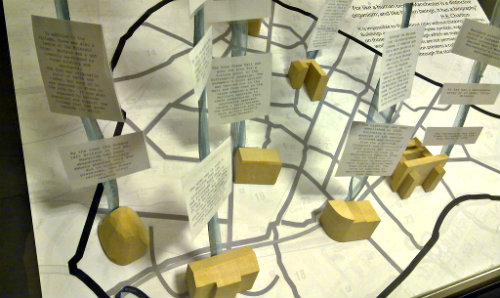Manchester on display 2009-10
Group displays at the Mansfield Cooper Building, University of Manchester.

Students in the core course 'Managing Collections and Exhibitions' curated in four groups, a display case installed in the foyer of Mansfield Cooper Building at the University of Manchester. Each group developed a mini display on the broad exhibition topic ‘Manchester’. The purpose of this project was to:
- Offer students an opportunity to critically reflect on the themes, lectures and readings of the course by developing an exhibit
- Provide students a practical aspect of the course’s teaching and learning
- Develop students' team working skills
- Provide a showcase for students' work
The Lost Stage
We knew from the start that we were keen to exhibit something of Manchester's hidden layers, peeling back time to show something lost, something that spoke of Manchester past and, therefore, of Manchester present. As discussions focussed on the 'dramatic' changes in Manchester in the 18th and 19th Centuries, the lost theatres of our city emerged as our subject, reflecting something of Manchester's social history. We also felt it would appeal to our audience, the staff and students of the School of Arts Histories and Cultures. Our exhibition would aim to give an alternative view of the city and an historical insight to inspire and intrigue Mancunians and newcomers alike. As you will see from our exhibition, the beginning of the 19th Century saw a flourish of theatre building in Manchester; a prime example of a countrywide emergence of an Industrial Revolution-fuelled bourgeoisie in search of entertainment and new social spaces. Manchester's theatres arrived to meet the demands of its new middle-class and some beautiful buildings emerged to house them. Within a century, those once lively theatres had largely gone, taking with them some wonderful histories of Victorians at play. We aim to tickle with tales from theatres past and tantalise with architectural clues.
The Multi-Story City
It is impossible to think of cities without thinking of buildings; buildings are powerful and complex symbols, important landmarks on those mental maps through which we make sense of the urban world. But such symbols are not permanent, they change over time.
Our exhibition explores the theme of 'Manchester' by examining certain aspects of the cultural biographies of its buildings so as to 'make salient what otherwise might remain obscure'. Our display views buildings as artefacts of Manchester and through examining the cultural biographies of these artefacts their often hidden meanings and therefore Manchester, as a living and changing metropolis from whence these buildings sprang, is revealed. The buildings that this exhibition investigates have been carefully chosen as their biographies each reveal a characteristic Manchester theme that we feel is an important aspect of its identity, such as Roman beginnings, the Industrial Revolution, politics, academic achievement, popular music, the IRA bomb and football. The display allows the viewer to glimpse hidden underground Manchester by revealing aspects of some of the networks of secret tunnels that lie below our feet. The purpose of this glimpse of the underground is to show the audience that there are many more hidden biographies in Manchester that are just waiting to be revealed. The display itself invokes a typical Manchester scene - rain falling down upon the buildings of the city.
Unveiling Voices
During preliminary discussions we focussed on Manchester as an international city. The student population of Manchester University alone at present consists of 7,400 international students. We became interested in preconceptions of those unfamiliar with the city and how these changed upon visiting and experiencing Manchester. We also considered hidden elements of Manchester; places which people had discovered whilst staying in the city. This was also extended to popular and well known attractions which, when mentioned in personal anecdotes were given a fresh perspective. Our method of display aimed to recreate a scrapbook effect, drawing numerous and diverse views of Manchester together. We colour coded different themes such as music, architecture and entertainment and highlighted text which referred to a specific theme in the corresponding colour. This playful method of cross referencing was intended to create a visually stimulating means of comprehending the information presented. The objects displayed within the case have little or no monetary value, their greatest worth being sentimental. Yet they become tangible specimens of personal accounts of Manchester. In this context they have worth projected onto them.
Your Manchester
We wanted to create a reflexive exhibition that would make people think about their own relationship with Manchester, and consequently go out and explore the city. Each member of the group chose an aspect of Manchester which appealed to them, the objects represent this. By presenting a variety of objects and ideas, our exhibition appeals to a wide audience and creates a starting point for further exploration of the city. By looking at the objects the viewer can create their own dialogue with the city. The photograph of the bee mosaic in Manchester Town Hall was chosen as the backdrop because it is the symbol of Manchester, representing the city's rapid growth during the Industrial Revolution, and the industriousness of its inhabitants.

